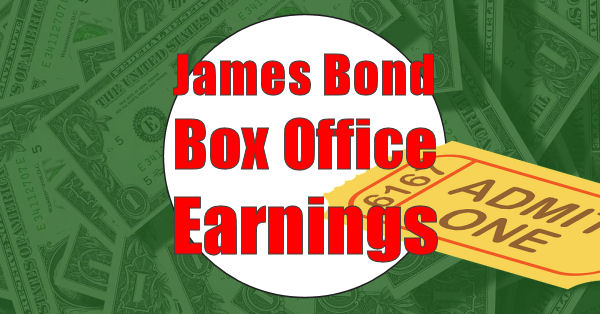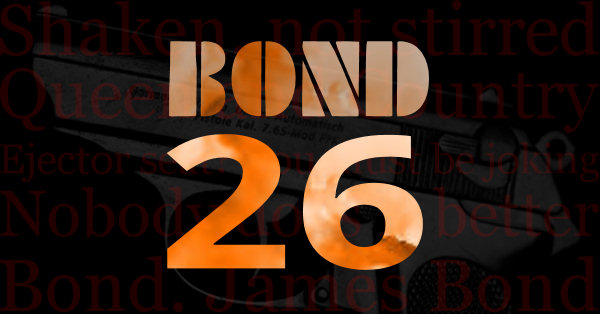A deep dive to establish the highest James Bond box office gross in real terms.

Skyfall notched up an impressive box office as the first billion dollar Bond film and was widely reported as the top grossing James Bond movie of all time. Despite expectations, the two subsequent films have failed to beat it. Perhaps No Time to Die could have done it without the pandemic, but we’ll never know.
The trouble with reporting straight box office figures though is that it only tells a small part of the story. For example, when the box office takings for the other films is adjusted for inflation it tells a markedly different story. When adjusted for inflation Thunderball was a billion dollar film too.
However, even inflation adjusted figures fail to tell the complete story. In this article I want to explore the topic in a bit more detail and identify the most successful James Bond films on a number of different measures.
Box office figures
The figures from the table below are mostly taken from The Numbers. Throughout this article the big assumption is that figures reported on third party websites are correct; if they’re not exact, they are likely to be pretty close.
This doesn’t really tell us much other than the general trend is up and that Skyfall grossed more than any other Bond film. What it fails to account for are the effects of inflation on those figures, underlined when you simply look at how the budgets have climbed over the years.
On the other hand, home video formats account for significant earnings on top of the cinematic release and so box office earnings of a 2021 film don’t compare directly with one released in 1962.
A note on budgets
For the four most recent Bond films there are better figures available than those quoted by The Numbers and elsewhere.
UK limited companies were formed for Quantum of Solace, Skyfall, SPECTRE and No Time to Die. As they are legally required to submit annual accounts we can find out exactly how much money the production has been allocated in pounds sterling.
Converting from pounds to US dollars at the exchange rate at the time filming started gives an idea of the dollar budget. It’s impossible to know the exact date the money was transferred – or even if it was a single transfer – but should be pretty close to the real number. So that’s what we’ve done in the most recent Bond films.
By that measure No Time to Die’s budget was quite a bit higher than the $250-$300 million usually reported. The budget comes in at just over $350 million.
That all said, let’s look at the numbers and find out which are really the top grossing James Bond movies.
| Title | Year | Budget | Domestic box office | Worldwide box office |
|---|---|---|---|---|
| Dr No | 1962 | $1,000,000 | $16,067,035 | $59,567,035 |
| From Russia With Love | 1963 | $2,000,000 | $24,800,000 | $78,900,000 |
| Goldfinger | 1964 | $3,000,000 | $51,100,000 | $124,900,000 |
| Thunderball | 1965 | $9,000,000 | $63,600,000 | $141,200,000 |
| You Only Live Twice | 1967 | $9,500,000 | $43,100,000 | $111,600,000 |
| On Her Majesty’s Secret Service | 1969 | $8,000,000 | $22,800,000 | $82,000,000 |
| Diamonds Are Forever | 1971 | $7,200,000 | $43,800,000 | $116,000,000 |
| Live and Let Die | 1973 | $7,000,000 | $35,400,000 | $161,800,000 |
| The Man with the Golden Gun | 1974 | $7,000,000 | $21,000,000 | $97,600,000 |
| The Spy Who Loved Me | 1977 | $14,000,000 | $46,800,000 | $185,400,000 |
| Moonraker | 1979 | $31,000,000 | $70,300,000 | $210,300,000 |
| For Your Eyes Only | 1981 | $28,000,000 | $54,800,000 | $195,300,000 |
| Octopussy | 1983 | $27,500,000 | $67,900,000 | $187,500,000 |
| A View to a Kill | 1985 | $30,000,000 | $50,327,960 | $152,627,960 |
| The Living Daylights | 1987 | $40,000,000 | $51,185,000 | $191,200,000 |
| License to Kill | 1989 | $42,000,000 | $34,667,015 | $156,167,015 |
| Goldeneye | 1995 | $60,000,000 | $106,429,941 | $356,429,941 |
| Tomorrow Never Dies | 1997 | $110,000,000 | $125,304,276 | $339,504,276 |
| The World is Not Enough | 1999 | $135,000,000 | $126,930,660 | $361,730,660 |
| Die Another Day | 2002 | $142,000,000 | $160,942,139 | $431,942,139 |
| Casino Royale | 2006 | $102,000,000 | $167,365,000 | $594,420,283 |
| Quantum of Solace | 2008 | $221,422,836 | $169,368,432 | $591,692,083 |
| Skyfall | 2012 | $233,214,200 | $304,360,288 | $1,110,526,992 |
| SPECTRE | 2015 | $309,272,890 | $198,532,644 | $872,132,644 |
| No Time to Die | 2021 | $351,574,294 | $160,891,007 | $760,008,036 |
Box office by actor
Add all those numbers up and the total domestic box office take for the 25 films is $2.22 billion, while worldwide it totals $7.67 billion.
The table below breaks down the box office take by actor. Daniel Craig’s films have earned more than any other actor but that’s hardly surprising given that he appeared in the five most recent films.
| Actor | Domestic box office | Worldwide box office |
|---|---|---|
| Sean Connery | $242,467,035 | $632,167,035 |
| George Lazenby | $22,800,000 | $82,000,000 |
| Roger Moore | $346,527,960 | $1,190,527,960 |
| Timothy Dalton | $85,852,015 | $347,367,015 |
| Pierce Brosnan | $519,607,016 | $1,489,607,016 |
| Daniel Craig | $1,000,517,371 | $3,928,780,038 |
Inflation-adjusted figures
To give a clearer idea of the amounts each film grossed at the box office, domestic and worldwide takings were adjusted for inflation using this US Consumer Price Index calculator and ranked in order. This gives a very different picture of how each film performed at the box office.
Domestic box office
On this basis Thunderball remains the top grossing Bond movie at the domestic US box office when adjusted for inflation, followed by Goldfinger and Skyfall. SPECTRE didn’t do too badly, making it to eighth place, ahead of Casino Royale but behind Die Another Day. But No Time to Die comes in after On Her Majesty’s Secret Service, widely considered a failure at the time, and For Your Eyes Only.
| Title | Year | Budget | Domestic box office |
|---|---|---|---|
| Thunderball | 1965 | $79,657,714 | $562,914,514 |
| Goldfinger | 1964 | $26,980,839 | $459,573,619 |
| Skyfall | 2012 | $282,426,821 | $368,586,085 |
| You Only Live Twice | 1967 | $79,299,970 | $359,771,443 |
| Diamonds Are Forever | 1971 | $49,564,800 | $301,519,200 |
| Moonraker | 1979 | $119,047,686 | $269,969,430 |
| Die Another Day | 2002 | $220,066,059 | $249,421,847 |
| SPECTRE | 2015 | $363,307,296 | $233,219,142 |
| Casino Royale | 2006 | $140,920,733 | $231,227,437 |
| From Russia With Love | 1963 | $18,222,353 | $225,957,176 |
| Quantum of Solace | 2008 | $290,611,413 | $222,291,433 |
| Live and Let Die | 1973 | $43,955,270 | $222,288,081 |
| Tomorrow Never Dies | 1997 | $191,079,252 | $217,664,067 |
| The Spy Who Loved Me | 1977 | $64,409,703 | $215,312,436 |
| The World is Not Enough | 1999 | $225,919,988 | $212,416,098 |
| Goldeneye | 1995 | $109,764,567 | $194,703,940 |
| Octopussy | 1983 | $76,978,464 | $190,066,825 |
| On Her Majesty’s Secret Service | 1969 | $60,774,278 | $173,206,692 |
| For Your Eyes Only | 1981 | $85,879,604 | $168,078,653 |
| No Time to Die | 2021 | $351,574,294 | $160,891,007 |
| Dr No | 1962 | $9,231,854 | $148,328,526 |
| A View to a Kill | 1985 | $77,732,900 | $130,404,609 |
| The Living Daylights | 1987 | $98,169,718 | $125,620,426 |
| The Man with the Golden Gun | 1974 | $36,275,353 | $108,826,059 |
| License to Kill | 1989 | $94,432,935 | $77,945,428 |
Worldwide box office
Globally Skyfall is in the number 1 spot, perhaps due to the massive Chinese market, with Thunderball trailing slightly and then Goldfinger and SPECTRE in fourth. What is interesting is how when you take inflation into account five Bond films are in the billion dollar club.
| Title | Year | Budget | Worldwide box office |
|---|---|---|---|
| Skyfall | 2012 | $206,181,017 | $1,344,869,262 |
| Thunderball | 1965 | $67,810,286 | $1,249,741,029 |
| Goldfinger | 1964 | $22,968,000 | $1,123,302,252 |
| SPECTRE | 2015 | $300,000,000 | $1,024,506,714 |
| Live and Let Die | 1973 | $37,417,838 | $1,015,994,676 |
| You Only Live Twice | 1967 | $67,505,749 | $931,565,964 |
| The Spy Who Loved Me | 1977 | $54,830,099 | $852,968,495 |
| Casino Royale | 2006 | $119,961,705 | $821,236,689 |
| Moonraker | 1979 | $101,341,818 | $807,604,140 |
| Diamonds Are Forever | 1971 | $42,193,067 | $798,544,000 |
| Quantum of Solace | 2008 | $256,972,014 | $776,579,669 |
| No Time to Die | 2021 | $351,574,294 | $760,008,036 |
| From Russia With Love | 1963 | $15,512,157 | $718,871,824 |
| Die Another Day | 2002 | $187,335,809 | $669,407,072 |
| Goldeneye | 1995 | $93,439,370 | $652,056,302 |
| On Her Majesty’s Secret Service | 1969 | $51,735,368 | $622,936,349 |
| The World is Not Enough | 1999 | $192,319,088 | $605,349,529 |
| For Your Eyes Only | 1981 | $73,106,799 | $599,010,238 |
| Tomorrow Never Dies | 1997 | $162,660,187 | $589,747,484 |
| Dr No | 1962 | $7,858,808 | $549,914,188 |
| Octopussy | 1983 | $65,529,518 | $524,853,163 |
| The Man with the Golden Gun | 1974 | $30,880,149 | $505,782,067 |
| The Living Daylights | 1987 | $83,569,014 | $469,251,254 |
| A View to a Kill | 1985 | $66,171,747 | $395,473,797 |
| License to Kill | 1989 | $80,388,000 | $351,126,420 |
Inflation adjusted box office by actor
If we look at each actor’s inflation adjusted box office take a different picture appears than before. Sean Connery’s films earned more at the box office than any other actor both domestically and worldwide. But while domestically Roger Moore’s films come in second place, worldwide Daniel Craig pips him to the silver medal.
| Actor | Domestic box office | Worldwide box office |
|---|---|---|
| Sean Connery | $2,058,064,479 | $5,371,939,256 |
| George Lazenby | $173,206,692 | $339,504,276 |
| Roger Moore | $1,304,946,093 | $4,701,686,575 |
| Timothy Dalton | $203,565,854 | $820,377,674 |
| Pierce Brosnan | $874,205,951 | $2,516,560,386 |
| Daniel Craig | $1,216,215,103 | $4,727,200,369 |
We can divide those figures by the number of films each appeared in to obtain each actor’s average box office per film. That shows Sean Connery in the top spot domestically with Daniel Craig leading worldwide. It doesn’t really mean anything beyond perhaps being of interest to stats nerds.
| Actor | Domestic box office | Worldwide box office |
|---|---|---|
| Sean Connery | $343,010,747 | $895,323,209 |
| George Lazenby | $173,206,692 | $339,504,276 |
| Roger Moore | $186,420,870 | $671,669,511 |
| Timothy Dalton | $101,782,927 | $410,188,837 |
| Pierce Brosnan | $218,551,488 | $629,140,097 |
| Daniel Craig | $243,243,021 | $945,440,074 |
Worldwide ROI
While the gross box office takings may be one measure of success, they are unlikely to impress anyone in business. The real question is how many dollars you make for each dollar invested. A billion dollar box office sounds impressive, unless the cost of the movie so high the studio made no profit.
And so a better measure of success is to measure Return On Investment (ROI). The production costs are subtracted from the gross box office takings and that figure is expressed as a percentage of costs.
When you compare the ROI, the picture that emerges is very different indeed. In fact, none of the more recent films even makes it into the top half of the list. No Time to Die is bottom, a combination of having a high budget with reduced earnings due to the pandemic.
| Title | Year | ROI |
|---|---|---|
| Dr No | 1962 | 5857% |
| From Russia With Love | 1963 | 3845% |
| Goldfinger | 1964 | 4063% |
| Thunderball | 1965 | 1469% |
| You Only Live Twice | 1967 | 1075% |
| On Her Majesty’s Secret Service | 1969 | 925% |
| Diamonds Are Forever | 1971 | 1511% |
| Live and Let Die | 1973 | 2211% |
| The Man with the Golden Gun | 1974 | 1294% |
| The Spy Who Loved Me | 1977 | 1224% |
| Moonraker | 1979 | 578% |
| For Your Eyes Only | 1981 | 598% |
| Octopussy | 1983 | 582% |
| A View to a Kill | 1985 | 409% |
| The Living Daylights | 1987 | 378% |
| License to Kill | 1989 | 272% |
| Goldeneye | 1995 | 494% |
| Tomorrow Never Dies | 1997 | 209% |
| The World is Not Enough | 1999 | 168% |
| Die Another Day | 2002 | 204% |
| Casino Royale | 2006 | 483% |
| Quantum of Solace | 2008 | 167% |
| Skyfall | 2012 | 376% |
| SPECTRE | 2015 | 182% |
| No Time to Die | 2021 | 116% |
Note that this doesn’t take into account the marketing budget, often said to be as large as the production budget. This article by the Hollywood Reporter mentions an average figure of $200 million in global marketing costs per movie.
Audience
Yet another measure of success is ignoring the top grossing James Bond movies and judging success on the number of people who saw each film. This we can estimate by dividing the box office gross by average ticket prices.
Domestic
By using average ticket prices in the US you can determine with a fair degree of accuracy the number of people who paid to see any particular film. On that basis Thunderball remains the most popular Bond movie in the US, ahead of Goldfinger and way ahead of Skyfall, in third place. SPECTRE is mid way down the table and No Time to Die sixth from bottom.
| Title | Year | Avg ticket price | US audience |
|---|---|---|---|
| Thunderball | 1965 | $1.01 | 62,970,297 |
| Goldfinger | 1964 | $0.93 | 54,946,237 |
| Skyfall | 2012 | $7.96 | 38,236,217 |
| You Only Live Twice | 1967 | $1.20 | 35,916,667 |
| From Russia With Love | 1963 | $0.85 | 29,176,471 |
| Moonraker | 1979 | $2.51 | 28,007,968 |
| Die Another Day | 2002 | $5.81 | 27,700,885 |
| Tomorrow Never Dies | 1997 | $4.59 | 27,299,407 |
| Diamonds Are Forever | 1971 | $1.65 | 26,545,455 |
| Casino Royale | 2006 | $6.55 | 25,551,908 |
| The World is Not Enough | 1999 | $5.08 | 24,986,350 |
| Goldeneye | 1995 | $4.35 | 24,466,653 |
| SPECTRE | 2015 | $8.34 | 23,804,873 |
| Quantum of Solace | 2008 | $7.18 | 23,588,918 |
| Dr No | 1962 | $0.70 | 22,952,907 |
| Octopussy | 1983 | $3.15 | 21,555,556 |
| The Spy Who Loved Me | 1977 | $2.23 | 20,986,547 |
| Live and Let Die | 1973 | $1.77 | 20,000,000 |
| For Your Eyes Only | 1981 | $2.78 | 19,712,230 |
| No Time to Die | 2021 | $9.57 | 16,812,017 |
| On Her Majesty’s Secret Service | 1969 | $1.42 | 16,056,338 |
| A View to a Kill | 1985 | $3.55 | 14,176,890 |
| The Living Daylights | 1987 | $3.91 | 13,090,793 |
| The Man with the Golden Gun | 1974 | $1.87 | 11,229,947 |
| License to Kill | 1989 | $3.97 | 8,732,246 |
It’s worth stating again that it is difficult to measure the success of a film now to one released in the 1960s. Now we have numerous home video formats including streaming services and many people choose to wait until they can catch a film in the comfort of their own home. In the 1960s there was no home video and television was restricted to far fewer channels.
In the UK there were two TV channels in 1962 when Dr No was released. A third was added when BBC2 started broadcasting in 1964 and Channel 4 only began its transmissions in 1982. Therefore there was little choice and no catch-up TV, making an evening – or weekend afternoon – visit to the cinema much more attractive. And that’s not to mention the tiny size of television screens in those days.
Worldwide
More problematic is the global audience size as there are no figures published for average ticket prices worldwide. Even if there were, there are likely such variations globally that such figures would be affected by audience geography. For instance, China is now important target market, but has not been so in the past and the cost of cinema tickets in China may be quite different from that of the United States.
However, just to see what we get anyway, I’ve used the vast simplification of calculating the worldwide audience based on US average ticket prices. I’m not even sure of the magnitude of error that this creates, but be sure that the numbers are almost certainly way off.
| Title | Year | Avg ticket price | Worldwide audience |
|---|---|---|---|
| Thunderball | 1965 | $1.01 | 139,801,980 |
| Skyfall | 2012 | $7.96 | 139,513,441 |
| Goldfinger | 1964 | $0.93 | 134,301,075 |
| SPECTRE | 2015 | $8.34 | 104,572,259 |
| You Only Live Twice | 1967 | $1.20 | 93,000,000 |
| From Russia With Love | 1963 | $0.85 | 92,823,529 |
| Live and Let Die | 1973 | $1.77 | 91,412,429 |
| Casino Royale | 2006 | $6.55 | 90,751,188 |
| Dr No | 1962 | $0.70 | 85,095,764 |
| Moonraker | 1979 | $2.51 | 83,784,861 |
| The Spy Who Loved Me | 1977 | $2.23 | 83,139,013 |
| Quantum of Solace | 2008 | $7.18 | 82,408,368 |
| Goldeneye | 1995 | $4.35 | 81,937,917 |
| No Time to Die | 2021 | $9.57 | 79,415,678 |
| Die Another Day | 2002 | $5.81 | 74,344,602 |
| Tomorrow Never Dies | 1997 | $4.59 | 73,966,073 |
| The World is Not Enough | 1999 | $5.08 | 71,206,823 |
| Diamonds Are Forever | 1971 | $1.65 | 70,303,030 |
| For Your Eyes Only | 1981 | $2.78 | 70,251,799 |
| Octopussy | 1983 | $3.15 | 59,523,810 |
| On Her Majesty’s Secret Service | 1969 | $1.42 | 57,746,479 |
| The Man with the Golden Gun | 1974 | $1.87 | 52,192,513 |
| The Living Daylights | 1987 | $3.91 | 48,900,256 |
| A View to a Kill | 1985 | $3.55 | 42,993,792 |
| License to Kill | 1989 | $3.97 | 39,336,780 |
This puts the global audience of Thunderball marginally ahead of Skyfall, but in truth either could be well ahead of the other, such is the potential margin of error. By this measure SPECTRE is in fourth place, behind Goldfinger, and No Time to Die is 14th. Clearly audiences were wary of returning to the cinema because of the pandemic.
Conclusion
While Skyfall’s $1 billion worldwide box office take is impressive, making it the first ever Bond film to breach that barrier, it is a poor measure of success. When the figures are adjusted for inflation, Skyfall is in third place domestically, behind Thunderball and Goldfinger, although globally it is just ahead of Thunderball thanks to expanding markets such as China.
In terms of audience size, Skyfall is well behind Thunderball and Goldfinger in the US, which is the only market we can measure the audience with any degree of accuracy.
But in terms of Return On Investment there is one film that has never been beaten. Dr No launched the James Bond series with an incredible 5857% ROI. Compare that with Skyfall’s 455% ROI, which looks like a failure in comparison.
This is an updated version of an article from 15th July 2015. This version published on 9th September 2022.










